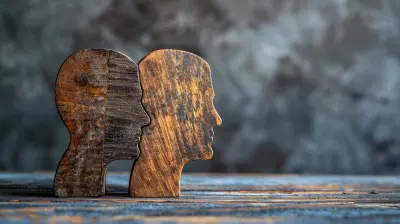The Influence of Peer Pressure on Adolescent Decision Making
8 July 2025
Let’s get real for a minute. Growing up is messy. Teenage years? Even messier. One minute you’re just trying to figure out who you are, and the next, bam—you’re being nudged, pulled, or straight-up shoved in a direction you’re not sure you want to go. And guess what’s often behind that sudden change in behavior? Yup. Good ol’ peer pressure.
In this no-fluff deep dive, we’re breaking down how peer pressure messes with adolescent decision-making and why it's such a big deal. Whether you're a teen, a parent, or just fascinated by psychology, grab your mental seatbelt—it’s going to be a bumpy ride.
What Exactly Is Peer Pressure?
Okay, let’s kick it off with the basics. Peer pressure is when people in your age group—your “peers”—influence you to do something. It can be direct ("Come on, just try it!") or sneaky and subtle (think eye-rolls and cold shoulders when you don’t go along with the group).Peer pressure comes in two flavors:
- Positive Peer Pressure: Your friends push you to study harder, join a club, or stay out of trouble. Not all peer influence is bad.
- Negative Peer Pressure: Your pals dare you to skip class, smoke a cigarette, or bully someone to fit in. This is the kind of pressure that puts a dent in your judgment.
Now, let’s focus on the real issue: how peer pressure hijacks the decision-making systems of teens.
Teen Brains: Built to Be Rewired
Before we go full-blown CSI: Brain Edition, here’s one thing you need to know—adolescents are literally wired for influence. Their brains are still under construction, especially the prefrontal cortex, aka the command center for decisions, risk-taking, and impulse control.Think of the teen brain as a car with a full gas tank (emotion and reward center firing like crazy) but sketchy brakes (the rational decision-maker still catching up). Add a few friends in the backseat yelling “Floor it!” and you’ve got a situation where peer influence can completely override logic.
Sound dramatic? It is. But it’s also science.
Why Peer Pressure Hits Hard During Adolescence
You’re probably wondering, "Why is peer pressure even a thing during the teenage years?"Simple. This is the phase when identity is being shaped. Teens are trying to carve out a space in the world—and figuring out who they are often involves comparing themselves to others.
Here’s why it hits differently during adolescence:
1. The Need to Belong Is Intense
Being liked, accepted, or seen as "cool" isn’t just a want—it feels like a need. Rejection? That feels like social death.
2. Risk Perception Takes a Hit
Toss a few peers into a situation, and teens are more likely to downplay danger. Solo, they might say “Nah.” In a group? “Let’s do it!”
3. Reward Systems Get a Serious Boost
Being accepted activates the brain’s dopamine response—the same brain chemical that lights up during sex, eating chocolate, or winning a jackpot. Who wouldn’t chase that high?
4. Social Media Adds Fuel to the Fire
Likes, shares, and followers amplify peer pressure 24/7. Teens are connected non-stop, and so is the influence.
Real-Life Examples: When Peer Pressure Controls the Wheel
Let’s look at what this looks like outside of textbooks:- Substance Use: A teen might say “no” to weed alone, but when all their friends are lighting up? It's hard to stay strong.
- Ditching School: “Everyone’s skipping the last period. Don’t be lame.” Flash-forward: detention.
- Risky Sexual Behavior: Teens might engage in sex sooner or without protection just to keep up with perceived “norms.”
- Bullying: Even kids who aren’t naturally aggressive might join in to avoid being left out or targeted themselves.
The worst part? Teens know some of these choices are dumb. But the promise of acceptance is louder than the voice of reason.
Types of Peer Pressure: Not All Pushes Are the Same
Let’s break this down even more. Peer pressure isn’t always screaming in your face. It wears many disguises:- Direct Peer Pressure: Someone tells you exactly what to do.
- Indirect Peer Pressure: You feel the urge to conform because "everyone else is doing it."
- Unspoken Peer Pressure: No one says anything, but you "get the vibe" that you're expected to act a certain way.
- Self-Imposed Peer Pressure: You put pressure on yourself to fit in, even if no one’s saying it out loud.
It’s like a manipulative magician—working in the background, pulling strings you didn’t even know existed.
The Impact on Decision Making: When Emotions Outweigh Logic
So, what does all this influence actually do to a teen's ability to make decisions?Spoiler alert: It messes things up.
1. Impulse Over Reason
Teens often act first and think later, especially when applauded by their peers.
2. Short-Term Thinking
Decisions are made with a “right now” mindset. Long-term consequences? Who’s that?
3. Moral Compromise
Even the "good kids" can find themselves in shady territory if the tribe says it's okay.
4. Self-Doubt Increases
The more teens are pressured, the more they start to question their own judgment. Confidence tanks.
Bottom line: Peer pressure doesn’t just affect what teens decide—it warps how they think.
Can Peer Pressure Ever Be a Good Thing?
Absolutely. Not all peer influence leads to chaos.Let’s flip the script for a second:
- A teen joins a community service club because their friends are in it.
- They study harder, because their buddies are all about getting into college.
- They stand up to a bully after someone in the friend group speaks out.
Positive peer pressure is real and can be a game-changer. The same emotional wiring that makes teens vulnerable to risky behavior can also push them toward greatness.
The key? Surrounding themselves with the right crowd.
How Parents, Teachers & Mentors Can Help
No, you can’t bubble-wrap your teen and hide them in a bunker until adulthood. But there are solid ways to armor them up.1. Help Build Self-Esteem
Teens with strong self-worth are less likely to bow to pressure. Celebrate their wins—even the small ones.2. Normalize Saying “No”
Teach them that it’s okay to be different. Role-play comebacks they can use in pressure situations.3. Talk (Don’t Lecture)
Open convos beat lectures every time. Ask questions. Listen more than you speak.4. Help Them Find Their Tribe
Encourage them to build friendships with people who respect their values, not challenge them.5. Use Real-Life Examples
Teens are all about relevance. Talk about situations they could face, not hypothetical gibberish.What Teens Can Do to Push Back
If you’re a teen reading this—first of all, props. This stuff will give you an edge.Here’s how you can fight back:
- Know Your Values: If you know what you stand for, it’s easier to walk away from what doesn’t fit.
- Have an Escape Plan: Create an excuse in advance. Seriously, even “I promised my mom I’d be home early” works.
- Find a Wingman: It’s easier to say no with a friend backing you up.
- Put It in Perspective: Will this matter in a week? A month? A year? Probably not.
- Don’t Be Afraid to Be the Example: Sometimes one brave person saying “no thanks” gives others permission to do the same.
Remember: You don’t need to be liked by everyone. You just need to like yourself.
Final Thoughts: Pressure Is Inevitable—Preparation Is Everything
Look, peer pressure isn’t going anywhere. Teen years are full of choices—some epic, some regrettable. But understanding how peer influence works, why it’s so powerful, and how to handle it? That’s the real superpower.Whether it nudges you into greatness or pulls you into trouble depends on one thing: how you respond to it.
So next time you feel that tug to do something you’re not sure about, hit pause. Ask yourself: “Am I doing this for me, or for them?”
That tiny moment of honesty can change everything.
all images in this post were generated using AI tools
Category:
Social PsychologyAuthor:

Jenna Richardson
Discussion
rate this article
1 comments
Danica Potter
This article highlights a crucial aspect of adolescence. Understanding the dynamics of peer pressure can foster empathy and support for young people navigating these challenges. By encouraging open conversations, we can empower adolescents to make informed decisions and embrace their individuality.
July 23, 2025 at 3:25 AM

Jenna Richardson
Thank you for your insightful comment! I completely agree that fostering open conversations is key to helping adolescents navigate peer pressure and embrace their individuality.


